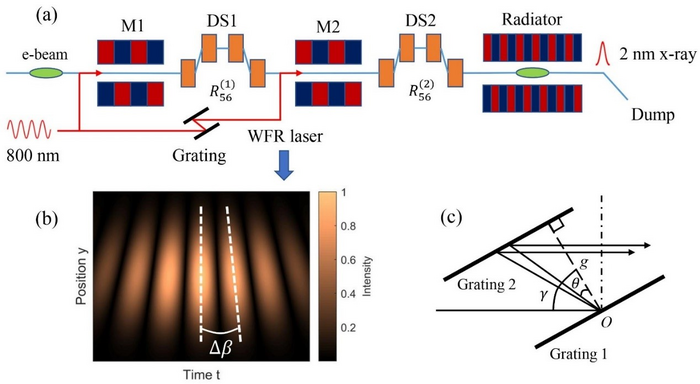Reviewed by Alex SmithSep 5 2022
Conforming to the fundamental absorption edges of matter, attosecond pulses with photon energies lying in the soft X-Ray range allow electron dynamics studies in next-generation semiconductor materials and live biological samples, like graphene and diamond.
 The layout for attosecond x-ray pulses generation (a) by using a wavefront rotation laser (b) generated through a double-grating configuration (c). Image Credit: Ultrafast Science
The layout for attosecond x-ray pulses generation (a) by using a wavefront rotation laser (b) generated through a double-grating configuration (c). Image Credit: Ultrafast Science
The development of attosecond X-Ray free-electron lasers (FELs) has been promoted by the immediate requirement of powerful attosecond pulses at X-Ray wavelengths, particularly in the water-window range. The improved self-amplified spontaneous emission (ESASE) technique is common for generating ultrafast pulses. Based on the ESASE, there are many developments to shorten the pulse duration or improve the peak power even more.
As SASE begins from electron beam shot noise and the shortest pulse duration is ultimately restricted by the slippage length, it is challenging to produce isolated and stable X-Ray pulses with several tens of attoseconds durations even now.
Many methods depending on the echo-enabled harmonic generation (EEHG) have been suggested to overcome this. In such methods, however, few-cycle laser pulses are usually needed, which results in additional difficulties for laser production and exchange.
To produce intense isolated X-Ray pulses that come with a duration of tens of attoseconds and cover the water-window range, the authors suggest a seamless and practical method based on EEHG. The representation of the suggested model is identical to the traditional EEHG setup, as illustrated in the image.
Replacement of the second seed by a wavefront rotation (WFR) laser is the difference, i.e., the seed laser is passed via a dispersion element, such as double gratings. The purpose of the WFR laser is to tailor the radiation pulse’s longitudinal profile. This method can successfully curb the bunching on both sides while preserving an isolated bunching in the middle owing to the sensitivity of seeded FEL toward external lasers.
The produced isolate attosecond pulses are natural synchronization to external lasers, which make them competent for performing high-resolution pump-probe experiments and offering a novel opportunity for attosecond sciences.
Compared to earlier methods with few-cycle lasers, the suggested method only needs a 100 fs conventional laser, hugely relaxing the requirements for the seed laser and making it trustworthy depending on present existing FEL facilities.
This type of coherent X-Ray light source could make it promising to study the electronic dynamics of the valence electrons—with the time scale of about 100 attoseconds and might broaden new boundaries of Ultrafast Science.
Journal Reference:
Xiao. Y., et al. (2022) Generating Isolated Attosecond X-Ray Pulses by Wavefront Control in a Seeded Free-Electron Laser. Applied Science. doi.org/10.34133/2022/9812478.